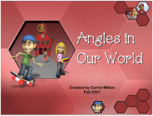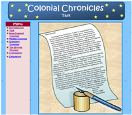Over the past few months, I have been more aware of my social learning network--and I'm amazed to see how much it has grown. It's been about 1 1/2 since I started my blog and setup my feed reader, but I've never used them as effectively as I have over the past several months. I feel more connected with educators from around the world (even though I'm still shy about posting comments and tweeting), began to look at technology integration from multiple perspectives, and learned how to easily find answers to my question. Participating in a social learning network has helped me to stay up-to-date with best practices and the newest research.
I still have lots of room to grow, however. I'd like to spend the next few months becoming a better twitter user. I'm always amazed when I see other teachers sending out a tweet asking for others to provide resources or take time to read & respond to student work. Within a few moments, they receive the support they needed. However, I know building that type of strong network takes time and persistence. In other words, I need to start giving before I can receive (and I think my 1 and only tweet won't cut it).
As I continue to improve my PLN, I'm thinking more and more about how I can help my students develop and grow from a learning network. One of the key reasons I learn and grow so much as I read blogs, explore Diigo bookmarks, and skim tweets is that I am personally interested in the topics. I am usually seeking out the information because I want to know, not because somebody is telling me to do so. Will the fact that I'll be requiring my students to post on a discussion board or research a specific topic limit the power of their network? Will they have to wait until they are older (and can have more freedom online) before they see the true learning potential of the web? How do I balance developing social skills online with digging deeper into concepts? Clearly, I'm still a little uncertain about how social learning networks can be incorporated into K-12 schools.
Labels: insys 497
Using Shelfari to Create Authentic Book Discussions
Posted by Carrie Mitton on Monday, December 8, 2008
This week I'll be teaching my students how to find, discuss, and review books on Shelfari.com. Some of my students helped create the video introduction (see above) by recording the narration. I used this video to kick-off the Shelfari project.
Today, I sent home the parent permission form and student agreement contract. In order for students to participate in Shelfari, they must return these forms.
If you're interested in using Shelfari with your readers, here the resources I created for this project (including my lesson plan):
Labels: insys 497, read-write web, research
Lesson Planning & Implementation (Blog Response #4)
Posted by Carrie Mitton on Thursday, December 4, 2008 I recently read a really fascinating article in The Reading Teacher called “Literacy Instruction With Digital and Media Technologies” by Diane Barone and Todd Wright that discussed how blended classrooms can engage our students (you’ll need to be a member of The Reading Teacher in order to read it). In the article, the authors cite 3 key ideas that teachers must remember:
I recently read a really fascinating article in The Reading Teacher called “Literacy Instruction With Digital and Media Technologies” by Diane Barone and Todd Wright that discussed how blended classrooms can engage our students (you’ll need to be a member of The Reading Teacher in order to read it). In the article, the authors cite 3 key ideas that teachers must remember:
“1. Simply using software programs on computers does not prepare students for new literacies’ expectations.
2. New literacies are deictic in that they constantly change and require teachers to embrace these changes.
3. New literacies are essential in classrooms so that equal opportunities are offered to all students.”
Just after I read the article, I cotaught a lesson with the library/media specialist in the computer lab. During this lesson, she wanted the students to locate information on World Book Online in order to answer questions. About half way through the period, she came over to me and asked, “Why do all the students think they can type the whole question into search box instead of the key words?” That basic question reminded me that simply using technology is not enough to develop literacy skills. The students need direct instruction, modeling, and support strategies for identifying key words, selecting a search result, and skimming the text. The lesson had a decent foundation, but our implementation needed improvement.
What was even more striking to me was that fact that we had just finished a key word search unit in connection with our science fair research. Just like every other skill the students learn in school, once is not enough. We need to teach, reteach, confer, model, and repeat until new literacy skills become second nature to the students.
It will take a lot of work—but I’m excited for the direction we’re heading in. Now if only I could teach in a one-to-one laptop classroom like the teacher in the article and the Floydada Independent School District do!

Labels: digital literacy, insys 497, read-write web
Ever since I started teaching, I've learned to loathe two different graphics:

Those two images have prevented me from using powerful tools that would allow my students to explore, connect, analyze, evaluate, and create. Each year, more and more sites are being blocked, and the low grumbling of teachers has become a louder, unified (and often unkind) protest. How are we to prepare our students to be 21st century citizens when we only have access to the marvels of 1999?
Slowly, a movement of change is coming. Just this past week, when I was blocked from using a really great educational site (Kerpoof) with my students, I felt that progress would never come to my district. Then, suddenly, the site was unblocked and a “progressive technology committee” was created that consists of teachers, tech department members, and administrators. Although it’s probably more of a trickle than a wave of change, it feels like we’re suddenly moving in the right direction.
We met for the first time this past Wednesday. The assistant technology coordinator began the meeting by explaining the current district filtering policy. Because of CIPA and board policy, we’re conservative in our filtering habits when compared to other districts. But, there is no doubt that we need to become more progressive in our use of web-based resources (including web 2.0). Before we change, we need to spend time building strong PR with teachers and parents to explains the reasons we’ll be using web 2.0 in the classroom. Our AUPs need to be updated. We need a mission statement, standards, and guidelines for best practices with regards to internet-enhanced instruction.
And then, he said the magic words: “We spent the last eight years building our infrastructure. Now it’s in the hands of the curriculum. We need you to tell us how we should be using the system. How can the curriculum drive our technology?” A shimmer of excitement, I’m sure, filled my eyes. It’s like music to my ears! The tech department is ready to shift the way it functions, as long as we help to build a foundation of educated teachers who understand and know how to keep our students safe, but not secluded.
I’m sure there will be many, many bumps in the road ahead. I’m sure there will be times of frustration and miscommunication. Still, I’m glad to know we’re on the right path—even if it’s just the beginning!
Research & the Reflective Practioner (Response 2)
Posted by Carrie Mitton on Monday, November 10, 2008I’ve been thinking a great deal about how my research habits have changed over the past 10 years. During my secondary school and undergrad days, I completed most of my research projects by going to an actual library, checking out hardcopy texts, and using the one journal database subscription purchased by my school. Research was something I conducted only when I was assigned a research paper. It was never self-directed or self-initiated.
I’ve found one problem with digital age research, though.

http://flickr.com/photos/shareski/2942564830/
As a result, sometimes I find myself being too hard on myself. Teaching is a complex process, and good teachers are constantly reflecting upon and refining their craft. But, I have to remember to give myself (and others!) time to grow, and not become overwhelmed by the tools and strategies that other great teachers are using. Sometimes, our small steps are really bigger than we see them to be in the moment, and as long as we're still moving forward (in the right direction), being overly critical of ourselves and others is counterproductive for the students and the school climate as a whole.
Labels: insys 497, read-write web, research
Over the past two weeks, the students worked in mixed-ability teams to write 2nd person point of view stories about kids who explore haunted houses. We turned the room into a radio station, and the kids recorded their stories, complete with some sound effects. We don't have an RSS feed for their work, but it's close to being a podcast.

The kids learned a lot and had a great deal of fun! Check out their work here.
Labels: read-write web, web 2.0, writing
Through the blog Teachers Love SMART Boards, I found this great web 2.0 tool, called Big Universe, that allows students to view and create digital picture books. I'm planning to use this tool as a publishing tool for writer's workshop stories.
You can check out Big Universe here.
Labels: web 2.0




